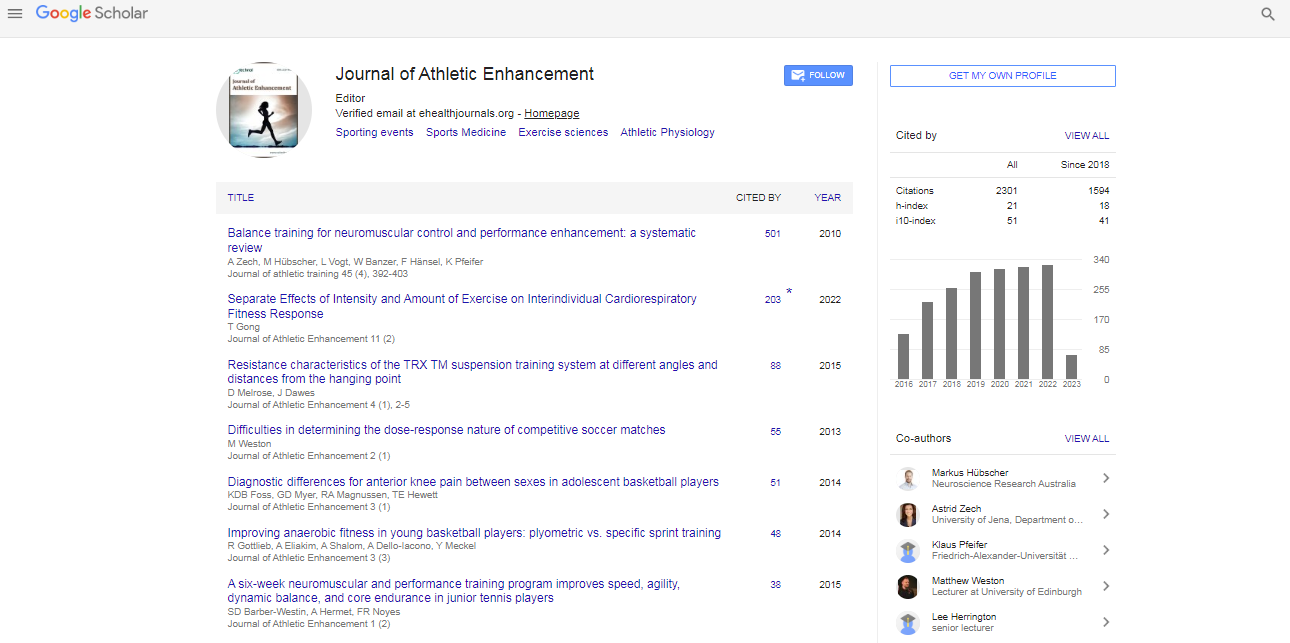Commentary, J Athl Enhanc Vol: 13 Issue: 2
Managing Leg Injuries in Sports: Prevention, Treatment, and Rehabilitation
Alex Popchak*
1Department of Sports, University of Pittsburgh, Pittsburgh, United States of America
*Corresponding Author: Alex Popchak,
Department of Sports, University of
Pittsburgh, Pittsburgh, United States of America
E-mail: popchakalex@upmc.edu
Received date: 26 February, 2024, Manuscript No. JAE-24-134562;
Editor assigned date: 29 February, 2024, PreQC No. JAE-24-134562 (PQ);
Reviewed date: 14 March, 2024, QC No. JAE-24-134562;
Revised date: 21 March, 2024, Manuscript No. JAE-24-134562 (R);
Published date: 28 March, 2024, DOI: 10.4172/2324-9080.1000116
Citation: Popchak A (2024) Managing Leg Injuries in Sports: Prevention, Treatment, and Rehabilitation. J Athl Enhance 13:2.
Description
Leg injuries are a common occurrence in sports, ranging from minor strains to severe fractures. Athletes, whether professional or amateur, often face the risk of sustaining injuries due to the physical demands of their respective sports. Understanding the types, causes, prevention, treatment, and rehabilitation of leg injuries is crucial for athletes, coaches, and medical professionals to ensure optimal performance and minimize the risk of long-term damage.
Types of leg injuries
Leg injuries in sports can encompass a wide range of conditions affecting different structures, including muscles, tendons, ligaments, bones, and joints. Some common types of leg injuries include:
Muscle strains: These occur when muscles are stretched or torn, often due to overuse, sudden movements, or inadequate warm-up. Hamstring and quadriceps strains are prevalent in sports that involve sprinting, jumping, and sudden changes in direction.
Ligament sprains: Ligaments are tough bands of tissue that connect bones and provide stability to joints. Sprains occur when ligaments are stretched or torn, commonly seen in sports with frequent twisting or pivoting motions, such as soccer, basketball, and football.
Fractures: Fractures refer to broken bones, which can range from stress fractures caused by repetitive stress to traumatic fractures resulting from direct impact or excessive force. Stress fractures are common in long-distance runners and athletes involved in high-impact activities.
Tendon injuries: Tendons connect muscles to bones and can be subject to overuse or acute injury, leading to conditions like tendonitis or tendon tears. Achilles tendon injuries are particularly prevalent in sports that involve running and jumping.
Causes of leg injuries
Leg injuries in sports can result from various factors, including:
Overuse: Repetitive stress on muscles, tendons, and bones without adequate rest and recovery can lead to overuse injuries, such as stress fractures and tendonitis.
Poor conditioning: Inadequate strength, flexibility, and endurance can increase the risk of leg injuries by compromising the body's ability to withstand the demands of sports activities.
Biomechanical issues: Poor technique, improper footwear, and biomechanical abnormalities can contribute to imbalances and faulty movement patterns, predisposing athletes to injuries.
Trauma: Direct blows, collisions, falls, and sudden impacts can cause acute injuries like fractures, ligament sprains, and muscle tears.
Prevention strategies: Preventing leg injuries in sports requires a comprehensive approach that addresses risk factors and promotes healthy training practices. Key prevention strategies include:
Proper warm-up and stretching: Dynamic warm-up routines and targeted stretching exercises help prepare muscles, tendons, and ligaments for physical activity and reduce the risk of strains and sprains.
Gradual progression: Incremental increases in training intensity, duration, and volume allow athletes to adapt gradually and minimize the risk of overuse injuries.
Treatment and rehabilitation
When leg injuries occur, prompt and appropriate treatment is essential to facilitate healing and minimize the impact on athletic performance. Treatment approaches may include:
Rest: Temporary cessation of sports activities allows injured tissues to heal without further stress or damage.
Ice and compression: Applying ice packs and compression bandages helps reduce pain, inflammation, and swelling following acute injuries.
Elevation: Elevating the injured leg above heart level can alleviate swelling and promote fluid drainage.
Physical therapy: Rehabilitation exercises and modalities prescribed by a physical therapist help restore strength, flexibility, and function while preventing re-injury.
Immobilization: Severe fractures or ligament injuries may require immobilization with splints, braces, or casts to facilitate healing and prevent instability.
Surgical intervention: In cases of complex fractures or severe ligament tears, surgical repair may be necessary to restore anatomical alignment and function.
Leg injuries are a prevalent concern in sports, but with proper prevention, treatment, and rehabilitation strategies, athletes can minimize their occurrence and optimize their performance and longevity in sports. By addressing risk factors, promoting healthy training practices, and seeking timely medical care, athletes can overcome leg injuries and return to their sport stronger and more resilient than before. Coordinated efforts among athletes, coaches, and medical professionals are essential for ensuring the well-being and success of athletes in sports.
 Spanish
Spanish  Chinese
Chinese  Russian
Russian  German
German  French
French  Japanese
Japanese  Portuguese
Portuguese  Hindi
Hindi 
